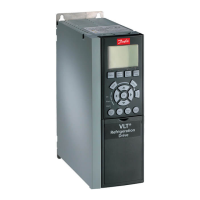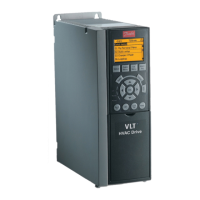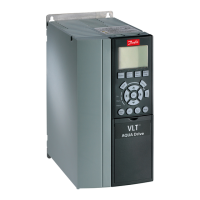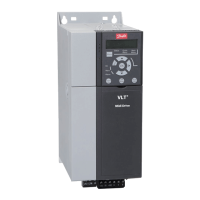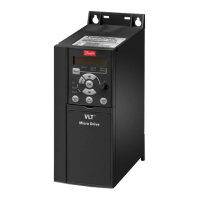decreases. The fan stops running when the IGBT
temperature drops below the fan turn-o temperature.
•
Fan turn-on temperature = 70 °C (158 °F)
•
Fan minimum speed temperature = 70 °C (158 °F)
•
Fan maximum speed temperature = 85 °C
(185 °F)
•
Fan turn-o temperature = 70 °C (158 °F)
In parallel drive systems, the speed of the heat sink fans is
based on the IGBT temperature of the warmest drive
module.
In E-sized drives, the fan is not set to turn on/o at specic
temperatures. Instead, the fan is set to maintain a target
temperature, so the temperature at which the fan turns
on/o is variable. The target temperature is determined by
the setting in parameter 30-50 Heat Sink Fan Mode. The fan
turns on at 40% load and increases in speed up to 84%
load, where the fan is at 100% speed.
Door/top fan
The speed of the door/top fan is determined by:
•
Control card temperature.
•
IGBT temperature.
•
Output current.
The fan runs at the highest of the 3 settings.
In D-sized drives, if the output is greater than 60% of the
nominal current, the fan runs at 100% speed. If the output
current is less than 60% of the nominal current, the fan
turns o.
In E-sized drives, the fan is not set to turn on/o at specic
temperatures. Instead, the fan is set to maintain a target
temperature, so the temperature at which the fan turns
on/o is variable. The target temperature is determined by
the setting in parameter 30-50 Heat Sink Fan Mode. The fan
turns on at 40% load and increases in speed up to 84%
load, where the fan is at 100% speed.
When the IGBT temperature reaches the fan turn-on
temperature, the fan starts and runs at its minimum speed.
As the IGBT temperature increases, the fan speed increases.
When the IGBT temperature reaches the fan maximum
speed temperature, the fan is running at 100% speed. As
the IGBT temperature decreases, the fan speed decreases.
The fan stops running when the IGBT temperature drops
below the fan
turn-o temperature.
•
Fan turn-on temperature = 70 °C (158 °F)
•
Fan minimum speed temperature = 70 °C (158 °F)
•
Fan maximum speed temperature = 85 °C
(185 °F)
•
Fan turn-o temperature = 70 °C (158 °F)
When the control card temperature reaches the fan turn-
on temperature, the fan starts and runs at its minimum
speed. As the control card temperature increases, the fan
speed increases. When the control card temperature
reaches the fan maximum speed temperature, the fan is
running at 100% speed. As the control card temperature
decreases, the fan speed decreases. The fan stops running
when the control card temperature drops below the fan
turn-o temperature.
In parallel drive systems, temperature readings are taken
for each individual module. Activation and speed control of
the module fans are synchronized through the MDCIC.
•
Fan turn-on temperature = 40 °C (104 °F)
•
Fan minimum speed temperature = 40 °C (104 °F)
•
Fan maximum speed temperature = 70 °C
(158 °F)
•
Fan turn-o temperature = 35 °C (95 °F)
Parameter 14-52 Fan Control commands the fans to run at a
xed speed. If the fans are commanded to run at 100%
speed, this setting overrides any other speed command.
In parallel drive systems, the function of the fans in the
individual modules is controlled in parallel through the
MDCIC. The fan speeds of the individual modules are
maintained equally using the control.
5.3.7 Load Sharing and Regen
Units with the built-in load sharing option contain
terminals 89 DC(+) and 88 DC(-). Within the drive, these
terminals connect to the DC bus on the input side of the
DC link reactor. The use of the load sharing terminals has 2
congurations.
In the 1
st
conguration, the terminals are used to tie the
DC bus circuits of multiple drives together. This congu-
ration allows a drive in a regenerative mode to share its
excess bus voltage with another drive in motoring mode.
This conguration reduces the need for external dynamic
brake resistors while also saving energy. Any number of
drives can be connected in this way, as long as they are of
the same voltage rating. Also, it can be necessary to install
DC reactors and DC fuses and mains AC reactors on the
mains. Attempting such a conguration requires detailed
considerations. Do not attempt without rst consulting
Danfoss Application Engineering.
In the 2
nd
conguration, the drive is powered exclusively
from a DC source. An external DC source is required. Do
not attempt without rst consulting Danfoss Application
Engineering
Internal Drive Operation
VLT
®
FC Series, D1h–D8h, Da2/Db2/Da4/Db4, E1h–E4h, J8/J9
58 Danfoss A/S © 02/2019 All rights reserved. MG94A502
55
